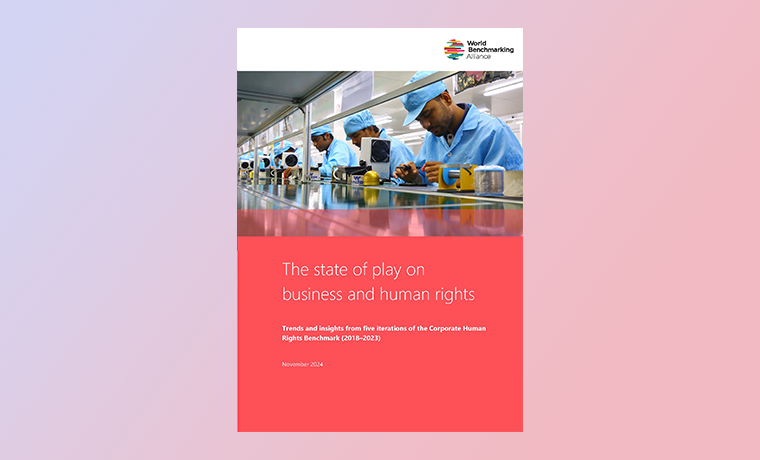The Value Chain Revolutionized: How Industry 4.0 Will Change the Future of the Garment Industry
August 20, 2019
The $2.4 trillion global fashion industry employs more than 50 million people around the globe. Given the sector’s far-reaching impact on socio-economic development in some of the poorest places in the world (see, for example, our latest research on Ethiopia), fashion brands that drive the global garment supply chain are under heightened scrutiny to respect internationally adopted environmental and labor rights standards. Many of the human rights issues in the supply chain are linked to the conventional yet lucrative “smiling curve” value chain, which allocates most of the economic gain to the activities at the beginning (R&D, design etc.) and at the back end (sales, marketing etc.) of the supply chain. This means that lower-value activities in the value chain, such as cutting and stitching, are carried out for lower prices in developing countries. This business model of outsourcing responsibilities has been at the core of value creation of global fashion brands for decades.
In a masterclass on the future of fashion taught as part of NYU Stern School of Business’ Fashion & Luxury MBA curriculum recently, Auret van Heerden, a senior advisor of the NYU Stern Center for BHR, challenged the sustainability of this model and argued that the garment industry faces four major disruptions, which will fundamentally transform the traditional supply chain model.
1. Scarcity of natural resources and therefore raw materials used to manufacture garments: The textile manufacturing industry has been condemned for its excessive usage of water, the world’s most precious resource. Cotton is known as an especially “thirsty” material, requiring up to 2,700 liters (713 gallons) of water when used to produce one T-shirt. Besides manufacturing, the dyeing, finishing and washing of fabrics are similarly water-intensive processes and often involve toxic chemicals that pollute limited water resources. Synthetically produced fibers, such as polyester and nylon, are equally exploitative of natural resources—namely crude oil. Given the finite nature of raw materials, fashion companies are seeking to improve their sourcing models, be it by “up-cycling” (i.e., reusing material without degrading its quality and composition) or utilizing unwanted, off-cut fabrics. A pioneer in responsible sourcing, Nike has acknowledged that resources are limited and under the “Nike Grind” program, developed a collection of recycled materials which are incorporated into new products. In 2018, Nike reported that 75 percent of its shoes and apparel contained some recycled material
2. Shortage of skilled labor force with an aptitude for technology: The days when fashion brands could outsource all of their manufacturing to cheap and unskilled workers in a country on the other side of the world are long gone. Advanced manufacturing technologies inevitably create demand for skilled factory workers who can use such technology. Companies are no longer looking for workers who can sew or cut fabric every day for many years, but rather those who can operate high-tech production lines. At the same time, the younger generation entering the workforce is not content with the repetitive, menial work their parents and grandparents performed for decades, often without comprehending the impact of their function on the end product. As a result of changing attitudes, the biggest challenge for many Chinese garment producing factories is a shortage of skilled labor. Some forward-looking brands for this reason have started to diversify their business processes to multi-skill workers. The brands teach these more sophisticated laborers transferrable skills that they can use in higher value-adding functions, thereby redistributing added value in the supply chain and flattening the traditional smiling curve.
3. Use of automation and robotics in garment production. The highly subcontracted and labor-intensive offshore garment-production model has yielded to “smart factories,” meaning automated garment assembly and manufacturing centers, that are run by computers enabling consistent efficiency, from inventory planning to logistics. Companies such as Adidas, Nike and Hugo Boss are heavily investing in building digitalized supply chains composed of robot-run assembly lines, which are automatically programmed based on incoming orders and can accommodate last minute changes to size, color and quantity. In Hugo Boss’s high-tech production plant in Izmir, Turkey, for example, business wear is produced using networked machines, extensive data analysis, and flexible processes that allow for customized products to be delivered overnight within Europe. Similarly, Nike has partnered with Flex, an electronic manufacturing service provider, at its innovation campus in California to produce personalized and rapidly delivered sneakers that create less waste. Nike’s competitor Adidas built robotic “Speedfactories” in Germany and the U.S., which use computerized knitting and assembly lines that once employed armies of low-cost, low-skilled workers. Automation will lead to some job losses in developing countries that are unable to adjust to these new technologies. With Nike and Adidas switching to automated production, their main suppliers in developing countries such as the Taiwanese footwear manufacturer Pou Chen, which employs over 350,000 workers, are expected to lay off thousands of workers.
4. Changing business models and consumer expectations: In 2017, e-commerce sales accounted for 9% of all retail sales in the U.S. and are expected to reach 12.4% in 2020. Orders placed through mobile applications, also known as m-commerce, have doubled since 2015. A large portion of this upsurge can be attributed to once-unimaginable conveniences, such as one-click purchase, same-day delivery, and customization, all of which have become part of the standard e-commerce experience. In this environment, digitalized supply chains have emerged as the sole business model that can meet heightened consumer expectations, enabling companies to list their products as always ‘in-stock,’ despite a zero-inventory strategy. High-tech supply chains also allow brands to engage in environmentally and socially responsible retailing by eliminating the waste generated by unsold, outmoded or faulty products. In examples of outmoded methods, Burberry reportedly destroyed $36.8 million in merchandise in 2018, while H&M burned 60 tons of new and unsold inventory worth a total of $4.3 billion.
In light of these disruptions, the supply chain of the future will be shorter, faster, and closer to final markets. This has major implications for developing countries that have relied on their place in the global supply chain to provide millions of jobs. Fashion brands as well as their largest suppliers in countries such as Bangladesh, Cambodia, and China must plan for fundamental transitions, many of which are driven by sustainability concerns. Investing in skilled workers able to move up the value chain and operate digital technology will best prepare economies that are currently dependent on garment exports. The foundations for a sustainable garment industry and future jobs in the 4.0 garment industry must be put in place now.
 Business Education
Business Education


